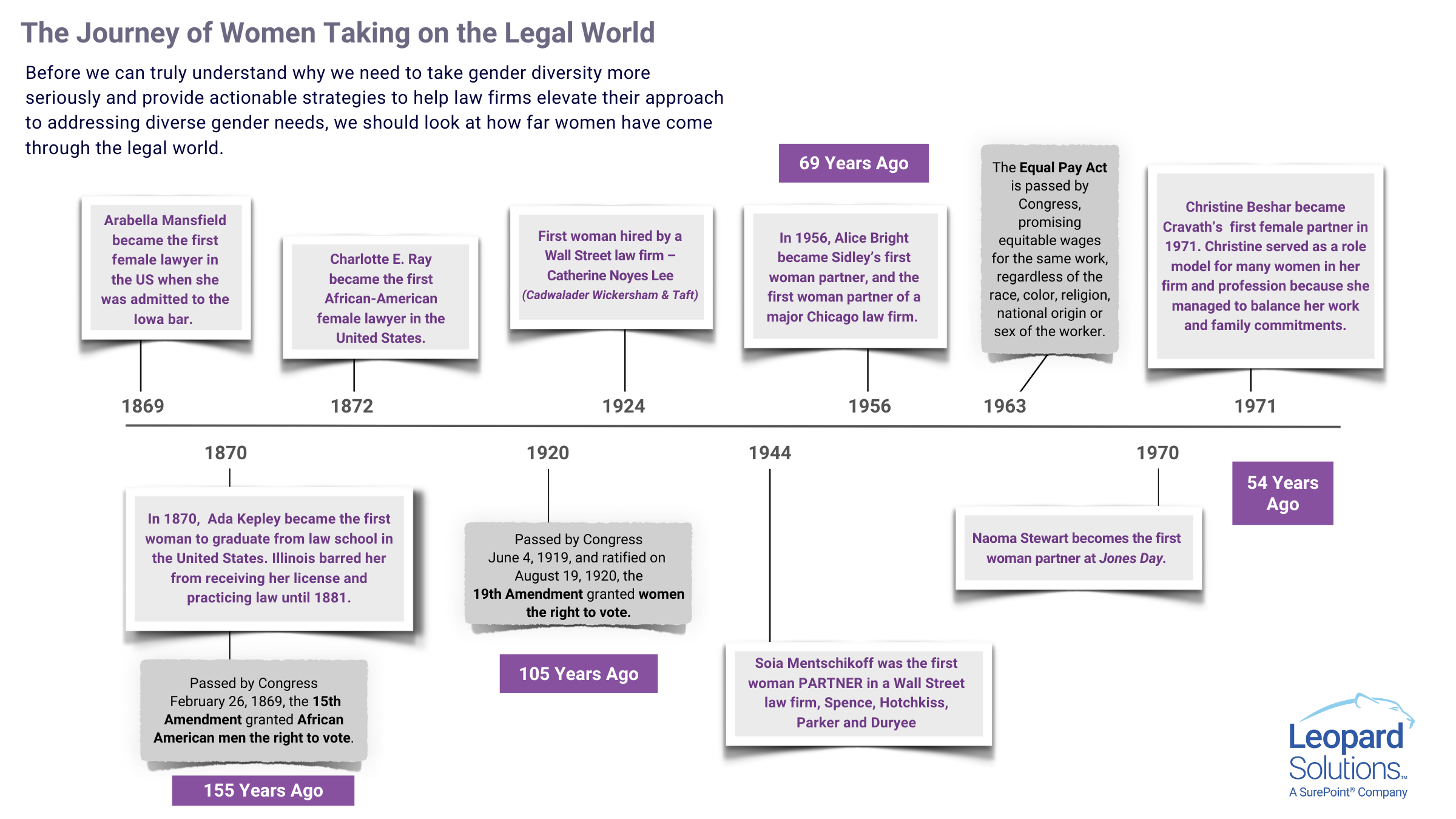Women have certainly come a long way in BigLaw. Some of the top law firms only installed their first female partners within the last 50 years — a stark reminder of the long-standing gender imbalance in the legal industry. Despite the progress, the struggle for women to attain partnerships and leadership roles remains a challenge even today. However, the resilience and success of several trailblazing women in top firms highlight not only the progress made but also the path forward.
Recent Leopard diversity data within the Am Law 200 firms shows incremental yet meaningful progress. Overall, gender diversity among all women attorneys in the top 200 firms has increased to 40.6% (up from 40% last year). Women now represent 52.2% of associates (up from 51%), 40.3% of counsel (up from 39%), and 29.2% of partners (up from 28%). Notably, the percentage of firms with 40% to 44% women attorneys rose to 58 (up from 53 in 2023), while firms with 45% to 49% women attorneys increased to 28 (up from 20).
While the gains may be incremental, any forward movement is significant — particularly against the backdrop of setbacks in diversity, equity, and inclusion (DEI) initiatives. In 2024, DEI efforts in law firms and corporations faced growing pressure, with DEI leaders being let go and departments scaled back. Still, the legal industry saw gains rather than losses in gender diversity — a testament to the perseverance and influence of female leaders who continue to break barriers in BigLaw.

Leading the Charge: Five Women Who Shattered Glass Ceilings
The following women stand out as trailblazers, each making history and reshaping the leadership landscape within the Am Law 200 firms:
1. Faiza Saeed
Faiza Saeed made history in 2016 when she became the first female presiding partner at Cravath, Swaine & Moore, a firm with a legacy dating back to 1819. Her appointment was a groundbreaking achievement in the traditionally male-dominated field of high-stakes dealmaking. Since stepping into the role, Saeed has guided Cravath through complex transactions and strategic decisions, reinforcing its position as a powerhouse in corporate law. Her leadership stands as a powerful example for women aspiring to reach the top ranks of BigLaw.
2. Jami Wintz McKeon
Jami Wintz McKeon broke new ground in 2014 when she was appointed chair of Morgan, Lewis & Bockius, making it the largest law firm globally to be led by a woman. During her tenure, McKeon has overseen significant growth and expansion, positioning the firm as one of the most influential in the legal industry. Her ascent to the helm of such a prestigious firm reflects the increasing influence of women in legal leadership — a shift that continues to shape the future of BigLaw.
3. Suzanne Turner
Suzanne Turner has made a significant mark at Dechert as the head of its pro bono practice. She has not only strengthened the firm’s commitment to public service but also introduced innovative tools, including generative AI, to enhance the efficiency of pro bono work. Turner’s ability to combine technological advancement with social impact has earned her recognition as a forward-thinking leader within the firm. Her work illustrates how women in leadership are driving both cultural and operational change in BigLaw.
4. Victoria Hills
Victoria Hills’ transition from Freshfields to Macfarlanes as a private equity real estate partner was a strategic win for Macfarlanes’ growing private capital team. Her deep knowledge of private equity and real estate has enhanced the firm’s competitive edge, strengthening its presence in high-value, complex transactions. Hills’ move reflects the growing prominence of women in sophisticated practice areas traditionally dominated by men.
5. Nicole Argentieri
Nicole Argentieri’s career exemplifies a successful shift from public service to private practice. After holding a senior leadership position in the U.S. Department of Justice’s criminal division, she joined Cravath, Swaine & Moore as a partner. Argentieri’s move reflects not only her versatility but also a broader trend of women stepping into influential roles at the intersection of government and private practice. Her expertise and leadership have added significant depth to Cravath’s litigation practice.
The Path Forward
While women have made undeniable strides in BigLaw, challenges remain. DEI initiatives are under fire, and the pressure to maintain momentum in gender diversity will likely grow in 2025. Nevertheless, the achievements of these five women — and the steady upward trend in gender representation within Am Law 200 firms — offer hope and a clear signal that the glass ceiling in BigLaw is not indestructible.
The next benchmark in 2025 will reveal whether the legal industry can sustain and build on these gains. But one thing is certain: the leadership and success of trailblazers like Faiza Saeed, Jami Wintz McKeon, Suzanne Turner, Victoria Hills, and Nicole Argentieri have already reshaped the future of BigLaw — and there is no turning back.

